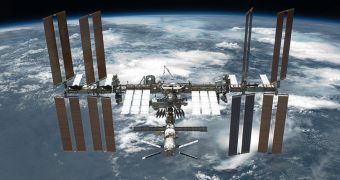The situation aboard the International Space Station has been rather tense over the past couple of days, ever since mission controllers urged astronauts aboard the orbital lab to prepare to take refuge in their life pod if need be. The emergency was caused by an incoming piece of space junk.
The debris could have posed a serious threat to the ISS, and so Mission Control asked the three astronauts currently making up Expedition 30 in low-Earth orbit (LEO) to get ready to take refuge in their Soyuz space capsule at a moment's notice.
In an announcement made by NASA officials on Wednesday, November 23, the agency revealed that the danger is now over, and that the crew has nothing further to worry about for the time being.
The analysis that led to this conclusion was carried out on November 22, by investigators at the NASA Johnson Space Center, in Houston, Texas. The JSC is the home of the agency' Astronaut Corps. In a statement, experts here said that tracking data now show no signs of danger.
The ISS is especially vulnerable to this type of threats, primarily due to the fact that even the smallest debris can penetrate its outer hull. Tiny pieces of metal, shards of paint, or larger components – from defunct satellites and rockets – travel at speeds of tens of thousands of miles per hour.
Lately, as more and more rockets are launched, the number and size of space debris is constantly increasing, making it extremely difficult for a new mission to launch safely in LEO or beyond.
As it is, the defensive shields surrounding the ISS are riddled with holes from micrometeorites and small space debris. But the entire, football field-sized structure needs to be moved out of the way of a single screw or bolt, if detected on time.
The object that prompted the most recent concerns was a fairly large one, measuring about 10 centimeters (4 inches) in diameter. It is a remnant of a Chinese weather satellite, which was destroyed back in 2007.
Early tracking predictions indicated that the object should pass within 2,800 feet (850 meters) of the ISS, which is considered to be dangerously close. The station's safety zone looks like a pizza box, extending widely on either side, but relatively narrow in height, Space reports.
Taking the safest route when dealing with space debris is always indicated, even if science aboard the ISS is stopped for a day or two. While traveling at 17,000 miles (28,000 kilometers) per hour, space junk would cut through the length of the station as if it wasn't even there.

 14 DAY TRIAL //
14 DAY TRIAL //